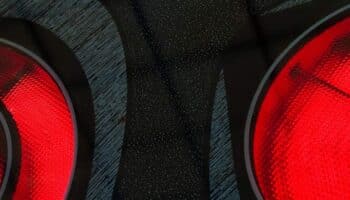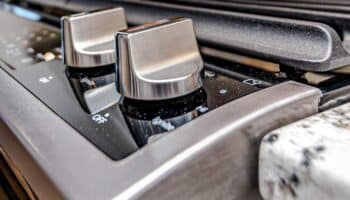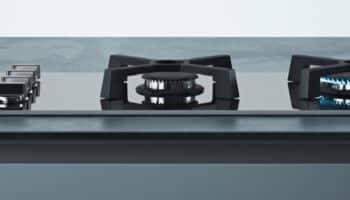We've independently reviewed this article to make sure it's as accurate as we can make it.
To find out more about our article creation and review process, check out our editorial guidelines.
Are you planning to upgrade your cookware, but can’t decide between Calphalon vs Cuisinart?
We don’t blame you – it’s a tough decision! Both companies produce high-quality cookware, and their products look pretty similar at first glance.
But when you delve a little deeper, there are some key differences in price, cooktop compatibility, and bonus features. Luckily, with the help of this article, you’ll be able to make the right choice.
When choosing between Calphalon vs Cuisinart cookware, consider your needs and preferences. Calphalon tends to be pricier, but also heavier and sturdier, making it ideal for frequent use. Cuisinart is more affordable, lightweight, and has unique designs.
Ready to learn more about their differences? Then let’s get started.
Calphalon vs Cuisinart
There are many collections available by Calphalon and Cuisinart, and they all offer different features and advantages.
In this article, we’ll concentrate on two product categories – impact-bonded and try-ply – and compare the two most popular collections in each category. See the table below.
| Calphalon Set | Cuisinart Set | Material |
| Classic | Chef’s Classic | Impact-Bonded |
| Premier | Multiclad Pro | Tri-Ply |
Before we move forward, it’s important to understand the difference between impact-bonded and tri-ply cookware.
In short, impact bonding is the process of adding a base of aluminum or copper to the bottom of a stainless-steel pan. This enhances conductivity at the base of the pan and provides high heat when cooking foods like meat and fish.
Tri-ply or 3-ply cookware is comprised of a layer of aluminum sandwiched between layers of steel. This triple layer extends to the top of the pan, making it a great conductor of heat, particularly along the sides.
As you might have guessed, tri-ply is a premium product for both brands. You can also find 5-ply and 7-ply if you want sturdy, high-performing cookware. But these products won’t be examined in this article as they are less common and may not be within everyone’s budget.
Now that we’ve got the details out of the way, let’s take a close look at some key performance categories and see how Calphalon and Cuisinart compare.
#1 Design
When you look at the design of Calphalon cookware, there’s no doubt that they are leaders in the kitchenware space. Both the Classic and Premier collections by Calphalon feature elegant stainless-steel construction, riveted handles, and tempered glass lids.
Their pans also have brushed stainless-steel exteriors that minimize the appearance of scratches or scuffs, and glass lids that provide a handy visual of the cooking process.
The clincher, however, lies with Calphalon’s Classic collection. It provides the user with clear measuring marks, pouring spouts, and straining lids. This means you don’t have to use extra cups or strainers while cooking, or make a guess when you need to reduce stock or sauce. Now that’s a clever design!
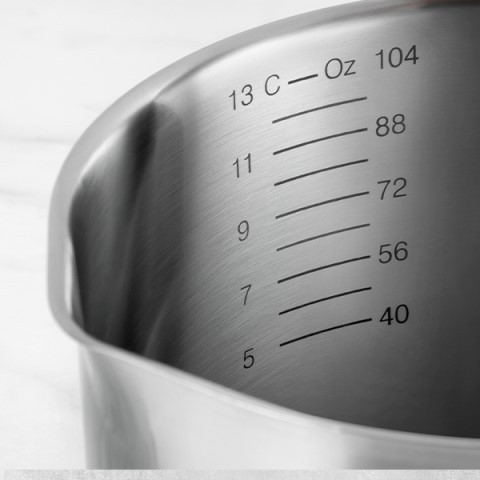
Cuisinart is also made from stainless steel, but most of its collections feature a mirror finish that may show scratches or fingerprints. It comes with both tempered glass and stainless-steel lids, so you can choose accordingly, and stylish cool-grip handles to make handling easy.
Unlike Calphalon’s Classic Series, the Chef’s Classic doesn’t provide any measuring lines or spouts, nor is it induction-ready. This could be a dealbreaker for many home cooks.
The Multiclad Pro, however, is a step-up. It has a brushed stainless-steel exterior and drip-free rims to keep your kitchen clean – and it’s compatible with your induction cooktop.
While it may seem as if Cuisinart falls a little short in this category, it redeems itself with its statement pieces. One of them is a hammered stainless steel cookware set. This collection has all the features of the Multiclad Pro, but with extra sparkle!
WINNER: Calphalon
#2 Durability
Most non-stick pans in the Calphalon collections will have a hard-anodized aluminum base. This makes their cookware stronger and conducts heat more effectively. Calphalon also claims that its Premier non-stick pan lasts 40 percent longer than its Classic counterpart.
Cuisinart, however, only has a few pans with hard-anodized aluminum. The others are made with standard aluminum, which is not as resilient and tends to scratch sooner.
While both brands use high-quality stainless steel for their construction and similar impact-bonding technology, there is a noticeable difference in thickness. Calphalon uses thicker steel in its Premier collection, making it heavier and sturdier.
By comparison, both Cuisinart collections and Calphalon’s Classic collection are lighter and thinner, which means they may not have the longevity of Premier or other premium Calphalon collections.
WINNER: Calphalon
#3 Cooking Performance
According to reviews online, both Cuisinart and Calphalon perform well when they are frying, grilling, stewing, or boiling. However, tri-ply cookware across both brands tends to heat more quickly and retain heat longer, particularly around the sides.
This gives you faster, more even cooking, which reduces the time you spend in the kitchen and improves the quality of your dishes.
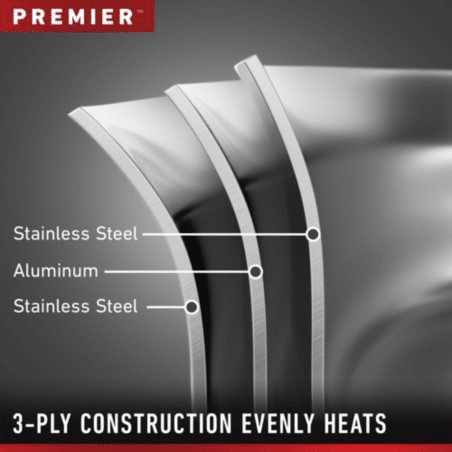
An analysis of performance wouldn’t be complete without looking at oven-safe temperatures. According to our research, Calphalon can withstand 450 degrees Fahrenheit (232 degrees Celsius), while Cuisinart can go up to 500 degrees Fahrenheit (260 degrees Celsius).
Whichever brand you use, you can go from stovetop to oven with ease – as long as you don’t exceed these temperatures. However, temperatures can vary depending on whether your cookware is stainless steel, hard-anodized aluminum or comes with tempered glass lids.
To avoid disappointment, check the maximum temperature in your instruction manual before placing the pot or pan in the oven.
WINNER: Calphalon & Cuisinart
#4 Price
Calphalon cookware is considered premium for a reason – it’s more expensive than most brands. When you look at its Classic 14-piece non-stick set, it’s about $100 more than its Cuisinart equivalent.
This isn’t surprising when you consider the spouts and measuring lines you get in the Calphalon Classic. Stainless steel sets, however, are roughly on a par.
When it comes to tri-ply sets, Calphalon offers an 8-piece stainless steel set for about $100 more than it would cost to get a 12-piece from Cuisinart.
What’s more, its 11-piece non-stick set is almost $500, while Cuisinart art doesn’t offer one in its Multiclad Pro collection. Instead, you would need to buy the pieces separately (there are only a few non-stick pans available) or buy a set in another collection.
WINNER: Cuisinart
#5 Warranty
Whether they’re impact-bonded or tri-ply, both Calphalon and Cuisinart offer lifetime warranties on their cookware.
This means that both brands will replace your cookware if it breaks or doesn’t perform at peak level. However, like all warranties, it won’t include misuse or damage, so keep this in mind if you make a claim.
WINNER: Calphalon & Cuisinart
Final Verdict
The choice you make in the end – Cuisinart vs Calphalon – all depends on your budget, needs, and preferences.
Both have pros and cons, and while Cuisinart may not offer the same features or durability, Calphalon is pricier and heavier to handle.
But one thing is clear: tri-ply cookware is preferable for both due to its superior heat conductivity and faster cooking time. If you still don’t know which way to swing, here’s a list to make it easier for you.
Buy Calphalon cookware if:
- You’ve got a higher budget and you want the best your money can buy
- You want heavy and sturdy cookware
- You use your cookware often
- You like the brushed stainless-steel look
- You prefer clear lids so you can monitor cooking
- You have an induction cooktop
- You want a lifetime warranty
- You want to use cookware that’s made in the USA
Buy Cuisinart cookware if:
- You’re on a budget and want to buy quality cookware at an affordable price
- You want lightweight cookware that’s easy to lift, move, and wash
- You prefer reflective stainless steel (although the tri-ply range has brushed stainless steel)
- You’re looking for a unique design, such as the Cuisinart copper or hammered steel range
- You want a lifetime warranty
We hope that this comparison guide has brought you one step closer to making a choice between Calphalon vs Cuisinart pans and pots. As you can see, both brands are on par in many categories, such as design, cooking performance, and warranty.
In the end, it all boils down to budget, features, and durability. This depends on whether you’re a casual cook looking for an affordable and reliable cookware range or a burgeoning home chef who wants to take their cooking to the next level!
Which Cookware has the Best Non-Stick Coating?
There is always debate about the safety and longevity of non-stick coatings. Calphalon cookware uses a 2-layer PTFE non-stick surface in its Classic collection and a 3-layer PTFE non-stick surface in its Premier collection.
Even though PTFE is the same as Teflon, Calphalon claims that their pans are PFOA-free, making them safer to use.
Cuisinart uses a QuanTanium surface made from titanium particles that are non-stick and scratch-resistant. However, when we dug a little deeper, we discovered that QuanTanium is also made of PTFE.
So, is there a difference between these coatings? Not really. They’re both safe to use. You just need to take some precautions to ensure their longevity and avoid toxic leaching.
Avoid preheating an empty pan, use a lower temperature, stir food with a non-scratch spoon, and replace the pan if the non-stick coating is peeling off.
If you want to avoid PTFE altogether, you can opt for Calphalon’s stainless steel cookware or ceramic collection. For those on a budget, consider Cuisinart’s GreenGourmet range, which is made from ceramic non-stick technology.
Calphalon and Cuisinart Cookware: A Quick History
Based in Ohio, Calphalon is one of America’s leading manufacturers of quality cookware, cutlery, and home appliances. Its founder, Ronald M. Kasperzak, pioneered anodized aluminum in 1968 using materials and processes found in the aerospace industry.
As a result, he created a cookware range that was resistant to corrosion and warping, which has been popular with chefs, cooking schools, and home cooks ever since.
Today, Calphalon boasts a large cookware range in stainless steel, ceramic, and non-stick. It enjoys popularity both here and abroad, and its range continues to set the standard for durable, high-quality cookware in the kitchen industry.
Cuisinart entered the kitchenware industry in 1971 when it began importing stainless-steel cookware. However, its founder, Carl Sontheimer, was obsessed with food preparation machines.
In 1973, after making some improvements to a model he found in France, he introduced the food processer to American kitchens.
While Cuisinart is best known for its kitchen appliances, it also boasts a premium cookware range, from stainless steel to non-stick aluminum.
It has also won many design awards and become a popular choice in kitchens around the world.
Conclusion
Thanks for checking out this guide.
While Calphalon & Cuisinart both have their merits, there’s really no wrong choice. If you simply have a gut feeling for one over the other – go for it!
If you enjoyed this guide and want to read more, see the articles below or sign up for your newsletter.
Thanks for reading. Have a great day!





